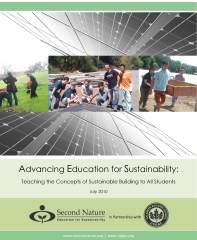By Ashka Naik, Director of Strategic Initiatives, Second Nature
(This article appears in the August, 2010 issue of The ACUPCC Implementer)
Within the Advancing Green Building in Higher Education Program, a capacity-building initiative funded by The Kresge Foundation, Second Nature has been building the sustainability capacity of many under-resourced institutions for the past two years. As Second Nature continues to work on this initiative, we thought of taking this opportunity to share with you some of the highlights and success stories of this program.
This initiative has a two-fold mission. The first one is to level the playing field and offer access to all under-resourced higher education institutions to embrace institutional sustainability. And, another long-term mission is to assist these institutions in committing to climate neutrality by enabling them to sign and implement the American College and University Presidents’ Climate Commitment(ACUPCC). Second Nature is directly working with more than 50 under-resourced institutions through this initiative.
One capacity-building activity that is already proving its success is the Kresge Fellowship Program. This program helps institution leaders network, learn and bring sustainability expertise and knowledge back to their respective campuses. Many Kresge Fellows are championing sustainability at their institutions and generating campus-wide movements that often steer the administration toward higher goals of institutional sustainability. Two such champions from the 2009 cohort of Kresge Fellows are Curt Maynard from the United Tribes Technical College and Ron Brooks from the Tennessee State University.
Mr. Maynard works with a small tribal college in Bismarck, North Dakota. As a result of Mr. Maynard’s perseverance and action, the President of the United Tribes Technical College recently committed to pursue climate neutrality by signing the ACUPCC. This is a stellar example of how an under-resourced institution, with the activism and commitment of its leadership, can aim for and implement sustainability practices on the campus.
The work of Mr. Brooks, Assistant VP of Facilities Management at Tennessee State University, is also an inspiring illustration of how one aware individual could drive the community toward sustainability. Not yet a signatory of the ACUPCC, Tennessee State University is a historically black institution with various financial and technical challenges that are often faced by many under-resourced institutions. However, with the help of the Kresge Fellowship Program, Mr. Brooks had the opportunity to attend the 2009 USGBC Greenbuild Conference, where he got introduced to myriad of issues, resources and technologies that could help him green his institutional infrastructure. By bringing this learning experience back to his campus and taking a few initial steps, such as changing thermostat settings for the first time on the campus, he helped the institution save $300,000 in energy bills!
He is currently in the process of involving many more students and staff on numerous sustainability initiatives. In his words, “Students are starting to get engaged like the other bigger schools, and I attribute that to the effort on the part of Second Nature and the Kresge Fellowship Program that allowed me to get these things out there…I don’t think that you would know how much that has impacted our campus!” The Second Nature team recently had the pleasure of interviewing Mr. Ron Brooks on his work and mission.
Another over-arching goal of this initiative is to develop a comprehensive strategy for teaching basic green building principles to all students that go through the academic journey at institutions of higher learning. Integrating sustainability into the core of students’ learning experiences ensures that the current and future workforce will have the skills and knowledge necessary to create a more sustainable economy and social environment.
 For this reason, Second Nature and the U.S. Green Building Council (USGBC) partnered to develop strategies that resulted in a document, “Advancing Education for Sustainability: Teaching the Concepts of Sustainable Building to All Students.” This strategy paper identifies a few key steps to integrate basic green building principles into the curricula, and offers a vast pool ofresources to assist institutions in this endeavor.
For this reason, Second Nature and the U.S. Green Building Council (USGBC) partnered to develop strategies that resulted in a document, “Advancing Education for Sustainability: Teaching the Concepts of Sustainable Building to All Students.” This strategy paper identifies a few key steps to integrate basic green building principles into the curricula, and offers a vast pool ofresources to assist institutions in this endeavor.
Second Nature’s effort is providing a crucial impetus for institutions of higher learning and a larger student population to move ahead in our common journey toward climate neutrality and a healthy, just and sustainable society. The success of this initiative also exemplifies that all institutions and communities, regardless of their size, location and diverse challenges, could indeed champion climate action and act as teachers for the rest of us!
Second Nature is currently working with the United Negro College Fund (UNCF) to build the sustainability capacity of minority-serving institutions, such as the Historically Black Colleges and Universities, Tribal Colleges and Universities, as well as the Hispanic Serving Institutions. With its Building Green at Minority-Serving Institutions Program, UNCF is offering green building learning institutes, trainings and technical assistance grants to minority-serving institutions that are interested in committing to sustainability.

Add new comment